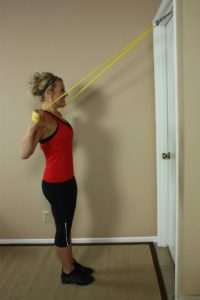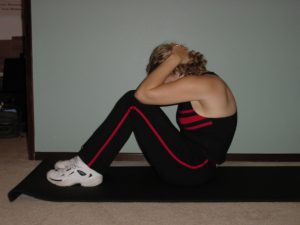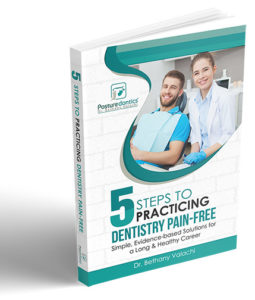|
-Dr. Bethany Valachi-
|
|
You wouldn’t put just any old forcep on any old tooth for an extraction. You need to match the appropriate instrument to the specific treatment need. For example, if you try to use an anterior forcep on a posterior tooth, it probably won’t work well…in fact, someone could get hurt!
Likewise, when it comes to exercise, you need to match the type of exercise to support the job you’re asking of your muscles every day in the operatory. For example, if you perform strengthening/power (anaerobic) exercise on your upper trapezius, you may likely develop painful trapezius myalgia since studies show that the upper traps easily become oxygen-deprived and ischemic in the dental operatory. Therefore, performing an anaerobic exercise on these oxygen-starved muscles worsens the condition and can lead to pain. I have seen the wrong type of exercises lead to pain problems countless times among dental professionals.
So let’s get this straight…. There are two general ways to condition muscles.
Muscular Endurance Training (aerobic): Targets type I muscle fibers, which have a high capacity for aerobic energy supply and are fatigue-resistant. This type of training  produces muscles that contract for a long duration at a low level. Postural stabilizing muscles, located closer to the spine, are largely made of Type 1 fibers, and when properly trained, enable an upright posture for prolonged periods of time without pain or fatigue. One example of an excellent muscular endurance training exercise for the lower trapezius involves an exercise band pulling down at a 45 degree angle (Fig. 1). WARNING! I did a Google search for ‘Best muscular endurance training exercises’ and 2 of the Top 5 Exercises are contra-indicated for dental professionals! Full sit-
 ups (Fig. 2) and push-ups can both worsen the painful imbalances to which dental professionals are prone. This is why it is imperative that you know which muscles to target in your exercise program, and you know how to exercise them without simultaneously activating the wrong muscles. (Don’t worry, I did all this for you in the CE Video Course, “Home Exercise Program for Dental Professionals”) Muscular Strength/Hypertrophy Training (anaerobic-Fig. 3): Targets type II muscle fibers, which hypertrophy and have a high capacity for rapid force production and fatigue quickly. This type of training produces muscles that contract powerfully, but only for a short duration. Power muscles, such as the quadriceps are made of a mixture of Type 1 and Type 2 fibers to enable both aerobic (jogging) and anaerobic (sprinting) activities.
 Injury prevention exercise programs should be customized to the occupation–a construction worker will have different muscular demands than a dentist. Hence, a good injury prevention exercise program for a construction work will have equal parts of muscular endurance and strength training. A well-designed injury prevention exercise program for a dental professional should focus mostly on muscular endurance training. This enables the dental operator to maintain an optimal posture for prolonged periods of time without pain or fatigue. It also allows the operator to periodically go into non-neutral, challenging postures for difficult tooth surfaces (think distobuccal of #15…) with less discomfort.
The importance of muscular endurance training for dental professionals is highly supported in the literature. From a Finnish dental study (Lehto 1991):
“…lack of muscle strength is seldom a critical factor…even among female dentists. While greater muscle strengthening may protect against overstrain in occupations where greater external forces are frequently applied, it does not seem to protect against symptoms caused by static postural loads.”
Another study found that dentists with better endurance of the back & shoulder muscles have less musculoskeletal pain (O’Sullivan 2006), and still another study found that female dentists with poor endurance of the neck & shoulder musculature had more neck pain (Rundcratz).
Why is muscular endurance important? Once a good baseline program of muscular endurance is established by dental professionals, strength training can then be slowly introduced (if  desired) as long as the muscular endurance training continues. Here’s why: A central tenet of human movement is that stabilization must occur in the proximal muscles & joints before the distal joint can move safely. This is the reason physical therapists are inundated with patients injured while participating in P90X and Crossfit exercises. It’s not that the exercises themselves are bad, but in order to perform most of them safely requires a great deal of stabilization in the trunk, shoulder girdle and hips. These stabilization exercises are often not present in sufficient quantity in these programs, and injury often occurs. How is the training different? Muscular endurance training involves high repetitions and low resistance and targets mostly the postural stabilizing muscles. Strength/bodybuilding training is just the opposite, and focuses on low repetitions and high resistance, targeting primarily the ‘mover’ muscles.
Make a resolution this year to do the right type of exercise that will keep your body pain-free and enable you the long and healthy career you deserve!
Need help?I have developed an evidence-based exercise program specifically for dental professionals.CLICK HERE |

 How can you protect your back, neck, shoulders, and hands for a long and healthy career?
How can you protect your back, neck, shoulders, and hands for a long and healthy career?
